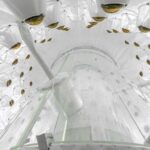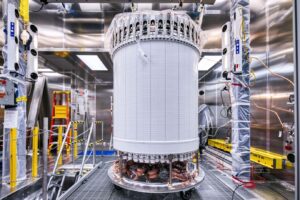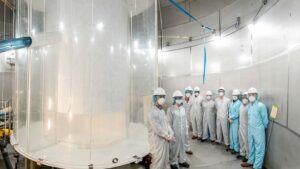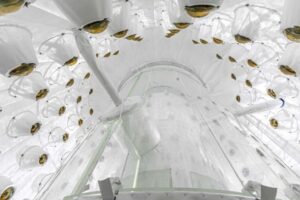
LZ Collaboration released first results on WIMP searches
On July 7th the LUX-ZEPLIN (LZ) Collaboration has released their first results on searching for Weakly Interacting Massive Particles (WIMPs), a candidate for dark matter. LZ is a detector installed at about 1500 m below ground in the SURF underground laboratory in South Dakota in the US (https://www.sanfordlab.org). The LZ is an international Collaboration with 287 members from different continents. LZ represents the continuation of a research program which begun with the LUX experiment. LZ is replacing LUX with a more advanced and sensitive detector.
The new results are derived from 65 days of exposure and establish a new record in searching for WIMPs. This is a tiny fraction of the 1000 days foreseen for the LZ project. WIMPs are a well-known candidate for dark matter. Dark matter accounts for 85% of all matter, therefore unveiling the nature of dark matter is a major challenge for science these days.
LZ is 7 ton active liquid xenon TPC, 1.5 m in diameter and height, viewed by 494 3-inch photosensors. The assembly of the TPC has been carried out in a radon-free clean room on ground at SURF before moving it underground inside the cryostat.
For the first time LZ has exploited in its outer detector an active neutron veto consisting in 17 ton of Gd-loaded liquid scintillator. The TPC and neutron veto are inside a water tank instrumented with 120 8-inch photosensors, which works as an active muon veto.
LZ data are consistent with the background-only hypothesis above the small tested WIMP mass of 9 GeV/c2. In the spin-independent scenario the WIMP-nucleon cross section is probed at the unprecedented level of 5.9×10-48 cm2 for a WIMP mass of 30 GeV/c2. In spite of this null result, LZ shows a crucial progress in hunting for dark matter and demonstrate the excellent performance of the detector waiting for more to come.
A paper describing the results can be found here. A recording of the presentation can be viewed on YouTube here. The slides from the presentation as well as supplemental material referenced in the paper can be found here.

The LZ central detector in the radon-free clean room at SURF after assembly. Photo by Matthew Kapust (https://www.sanfordlab.org)

Members of the LZ collaboration in the water tank after the outer detector installation.
Photo by Matthew Kapust (https://www.sanfordlab.org)

LZ Outer Detector. Photo by Matthew Kapust (https://www.sanfordlab.org)



